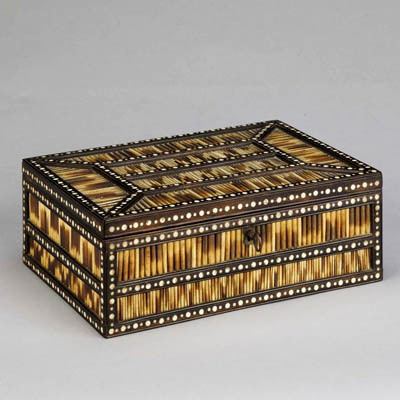 | ||
Porcupine quill boxes make up a small part of the decorative output of Southern Ceylon. Porcupine quill boxes were finely inlaid with ivory discs and porcupine quills between bands of ebony. They were highly valued for their rich timbers and intricate craftsmanship.
The production of porcupine quill boxes and furniture falls between around 1850 and 1900. There are several documented examples that give the outline for these dates. In particular there is one in the V&A museum, which was given to Queen Victoria c. 1850.
Production of Ceylonese ebony and porcupine quill boxes was focused in three areas of southern Ceylon – Galle, Matara and Matura – all important trading posts, benefiting from the thriving export trade. The style of the boxes was very much aimed at the demand of the European market, boxes imitated traditional English forms such as jewellery boxes, sewing baskets and writing boxes. Although porcupine quill boxes were originally made for English residents, by the late 19th century, there was a thriving commercial export trade.
There are numerous porcupine quill boxes on the market, and they vary in quality enormously. As a general rule, the more work that has gone into the box, the finer and rarer it is.
The number of ivory dots and their close proximity together are a good indication of a valuable box. The finest boxes from Galle may have an ivory disc positioned every .5 cm on all of the ebony borders. By contrast a lesser box may have dots 1 inch apart or more. Boxes from Matara often had two small dots directly above and below larger dots all around the border.
The quality of the porcupine quills used is also a detail to look for. The porcupines quills can grow up to 40 cm long, they naturally drop quills so they are easily collected by hand. The base is thick and it tapers to a fine and very sharp point, the quills are very strong and to be used in box production must be sliced in half length ways. Clearly, boxes with broader quills from cuts near the quill base are cheaper. Conversely those with fine quills are much more desirable and thus valuable. There are two types of quill, the first with distinct dark and white bands and the other with plain blond colouration. The coloured quills were used to make chevron patterns, whilst the blond quills offered a cleaner look.
The most common boxes are up to 11 inches in width, some have sliding lids and others are hinged with a lock on the front. Typically these boxes are not exceptional, however there is a small group of boxes from Matara that tend to be superior in the use of quills and ivory discs and these boxes command high prices. In general, boxes larger than 13 inches wide tend to be superior, they were aimed at the more affluent client who could afford the extra time and attention to detail.
Is it warped? The quality of timber used was not always very good, it typically was not treated or dried so the potential for warping is high. In short, a warped box is not a desirable box and it is always worth checking.
